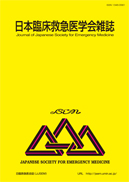Volume 25, Issue 1
Displaying 1-17 of 17 articles from this issue
- |<
- <
- 1
- >
- >|
-
2022 Volume 25 Issue 1 Pages i-iv
Published: February 28, 2022
Released on J-STAGE: February 28, 2022
Download PDF (237K)
ORIGINAL ARTICLES
-
Article type: ORIGINAL ARTICLE
2022 Volume 25 Issue 1 Pages 1-10
Published: February 28, 2022
Released on J-STAGE: February 28, 2022
Download PDF (1087K) -
Article type: ORIGINAL ARTICLE
2022 Volume 25 Issue 1 Pages 11-20
Published: February 28, 2022
Released on J-STAGE: February 28, 2022
Download PDF (977K) -
Article type: ORIGINAL ARTICLE
2022 Volume 25 Issue 1 Pages 21-27
Published: February 28, 2022
Released on J-STAGE: February 28, 2022
Download PDF (545K) -
Article type: ORIGINAL ARTICLE
2022 Volume 25 Issue 1 Pages 28-34
Published: February 28, 2022
Released on J-STAGE: February 28, 2022
Download PDF (493K)
RESEARCHES
-
Article type: RESEARCH
2022 Volume 25 Issue 1 Pages 35-40
Published: February 28, 2022
Released on J-STAGE: February 28, 2022
Download PDF (415K) -
Article type: RESEARCH
2022 Volume 25 Issue 1 Pages 41-45
Published: February 28, 2022
Released on J-STAGE: February 28, 2022
Download PDF (313K) -
Article type: RESEARCH
2022 Volume 25 Issue 1 Pages 46-52
Published: February 28, 2022
Released on J-STAGE: February 28, 2022
Download PDF (766K) -
Article type: RESEARCH
2022 Volume 25 Issue 1 Pages 53-56
Published: February 28, 2022
Released on J-STAGE: February 28, 2022
Download PDF (477K) -
Article type: RESEARCH
2022 Volume 25 Issue 1 Pages 57-61
Published: February 28, 2022
Released on J-STAGE: February 28, 2022
Download PDF (321K) -
Article type: RESEARCH
2022 Volume 25 Issue 1 Pages 62-70
Published: February 28, 2022
Released on J-STAGE: February 28, 2022
Download PDF (740K) -
Article type: RESEARCH
2022 Volume 25 Issue 1 Pages 71-77
Published: February 28, 2022
Released on J-STAGE: February 28, 2022
Download PDF (612K) -
Article type: RESEARCH
2022 Volume 25 Issue 1 Pages 78-83
Published: February 28, 2022
Released on J-STAGE: February 28, 2022
Download PDF (451K)
CASE REPORTS
-
Article type: CASE REPORT
2022 Volume 25 Issue 1 Pages 84-88
Published: February 28, 2022
Released on J-STAGE: February 28, 2022
Download PDF (584K) -
Article type: CASE REPORT
2022 Volume 25 Issue 1 Pages 89-93
Published: February 28, 2022
Released on J-STAGE: February 28, 2022
Download PDF (445K) -
Article type: CASE REPORT
2022 Volume 25 Issue 1 Pages 94-97
Published: February 28, 2022
Released on J-STAGE: February 28, 2022
Download PDF (595K)
-
2022 Volume 25 Issue 1 Pages 104
Published: February 28, 2022
Released on J-STAGE: February 28, 2022
Download PDF (171K)
- |<
- <
- 1
- >
- >|
